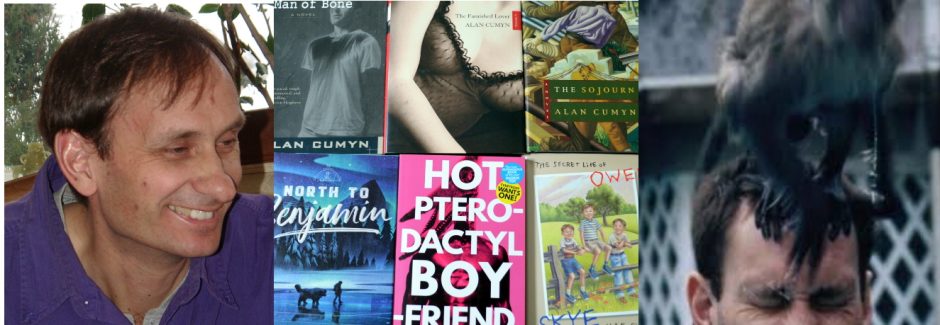Thursday 27 Dec. 2018: Where did December go? There ought to be an inquiry into how the days slipped by so quickly. But tomorrow we leave for Hong Kong, then home. We’re ready to go (if not actually ready for the winter that awaits), but we’ve had a fabulous time, with much to chew over in the months and years to come, including our memory of the amazing fresh fruit … as pictured here in a floating market.

Fresh fruit at a floating market on the Mekong
Our daughters Gwen and Anna and friend Sam joined us mid-month.
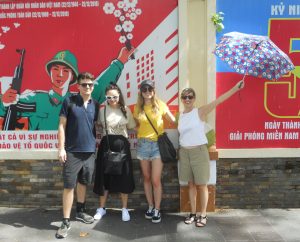
Salutations from Saigon
They travelled with us through the hectic streets of Saigion, and to the resort town of Vungtau, then to the tunnels Cu Chi and south to the Mekong.
We haven’t all been together travelling in south Asia since Suzanne and I moved to Indonesia with the kids in 1994.

All together in Salatiga, Indonesia 1994
To all, a gift of flowers and color from this remarkable country.

A blast of bougainvillea
We’ve been fortunate in the people we’ve met, the things we’ve been able to see, the small touches that are starting to sink in about the local history and culture. Here’s a clip of heavy rain falling on a lotus leaf outside our room at the Mekong Riverside Boutique Resort on Christmas Eve. There’s a metaphor here, I’m sure of it… For now, it’s just fun to watch the drops merging and sliding as more rain falls.
Saturday 1 Dec. 2018: guest blogger — Suzanne Evans:

Many drips!
On Thursday morning I was late heading out to my meeting with the women’s group that I joined here. Our wonderful housekeeper, Mrs. Lan was at the apartment with a workman examining the water damage on the kitchen ceiling from last weekend’s Typhoon Usagi. Alan and I spent much of Sunday evening emptying pots and squeezing out towels, trying to prevent the water from draining into the apartment below. In bed that night we knew from the intensity of the plinking and plonking that our water concert was nowhere near the end. Mrs. Lan, who arrived to clean Monday morning, found rags to put in the bottom of the pots to dampen what was by then a really annoying sound. People here know how to deal with monsoon levels of rain, but this was special. Schools were closed on Monday and the streets, even during rush hour, were calm. Many parts of the city had been flooded in what turned out to be the heaviest rainfall ever recorded in Saigon in a 24-hour period.
When Mrs. Lan and the workman arrived on Thursday they headed up through the trap door in the bathroom ceiling to have a look at the damage. The next thing we knew, yelps of fear and pain were coming out of the bathroom. Alan rushed in and found Mrs. Lan hanging through the trapdoor scrambling to find her footing after the ladder had slipped. He helped her down and although crumpled, she was OK. After that the water damage didn’t seem so important.
I set off to my meeting down the street at a trot. We were having a special speaker come and talk about dengue fever. The mosquito-borne virus

Dengue-bearing mosquito
seems to be ramping up in the city and there was extra concern that the flooding would make for an infestation of mosquitoes. I didn’t want to miss the talk, but was once again delayed. On the other side of the street was a man playing a flute. His music seemed liquid and slightly melancholy. For a moment I felt pulled out of the urban landscape by the sound of this most traditional of Vietnamese instruments. I wanted to tape him, but sadly there was no time then or after the meeting. Our days are slipping away so quickly now, I wondered if either of us would hear this street music again.
Alan and I spent the rest of the afternoon with our friends Helena and Sang, the latter being also our travel agent and guide to all things Vietnamese. We traveled to a restaurant on the outskirts of Saigon.
the latter being also our travel agent and guide to all things Vietnamese. We traveled to a restaurant on the outskirts of Saigon.
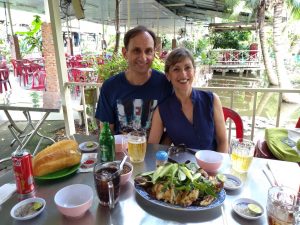
No mosquitoes at the moment…
Shaded under bamboo thatch we feasted on grilled chicken, sticky rice, steamed melon and a hotpot soup of snakehead fish. The restaurant is built over pools of still water alive with fish and silent mosquitoes. Madly scratching my ankles on the way home, I wondered if any of my new bites were from dengue-infected mosquitoes…
No fevers yet and happily Alan and I came across another flute player the next day playing beside “our” park, the old European cemetery at the end of our street. Alan filmed the musician with his back-up chorus of motorbikes – essence of Vietnam.
Sunday 25 Nov. 2018: It has been another exceptional week for us here in Vietnam. As a bit of an escape from the congestion in Ho Chi Minh City, we took an overnight trip to beautiful Vung Tau, which is a couple of hours south of the city by hydrofoil.

Leman Cap resort, Vung Tau
We instantly felt like we had wandered into a paradise of blue skies, fresh air, and spectacular flowers. (There are also oil rigs out there in what China calls the South China Sea, and Vietnam calls the East Sea, and the Philippines has started to call the West Philippines Sea… But it’s hard to see past the infinity pool.)

Infinity pool

Christmas just barely under wraps
Back in town, Christmas preparations are already highly noticeable, which is odd given the Buddhist nature of much of the country. Tourists are also beginning to arrive in large numbers, as the weather turns cold in northern latitudes. Officially the major sources of tourists here are from China, South Korea, USA and Japan, but there also seem to be a lot of Russians.

On the climb
There are of course strong pockets of Catholicism. Vung Tau boasts a Jesus statue taller than the one in Rio de Janeiro. It’s a thousand steps to stand on Jesus’ shoulder, then a dizzying view!
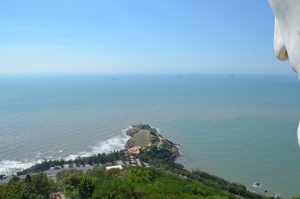
A thousand steps high

War Remnants Museum
A final few words about the War Remnants Museum in Ho Chi Minh City. We visited for the second time yesterday, and were as disturbed as we were the first time in early September. Yes, that is a guillotine on display, last used in 1960.

Thuy Linh, artist
The young artist pictured here, Thuy Linh, is a second generation victim of Agent Orange. She uses her feet in miraculous ways because she was born without hands.
Heavy rains today, and almost cool temperatures: about 25°C. We are grateful for the beauty of our balcony garden!
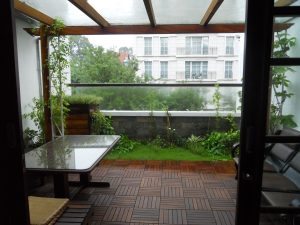
Sheltered balcony, Phung Khac Khoan St. HCMC
Saturday 10 Nov. 2018: guest blogger — Suzanne Evans

Tao Dan Park, Ho Chi Minh City (Saigon)
A couple of weeks ago on our wanders through the streets of Saigon we came across a beautiful oasis – Tao Dan park. Just steps into this park and the air smells sweeter, the noise of the constant traffic is muffled and there is no fear of being run over by a motorbike. We have gravitated to the parks within walking distance from our apartment to find some relief from the intensity of this city and to watch all the life that goes on within their boundaries. This particular park was established in 1868 as the “Jardin de la ville.” The director of the botanical gardens at the time planted it with many unusual plant and tree species. Some of the trees there now are so immensely tall they look as though they were among the original inhabitants of the park.

Early morning workout Tao Dan Park HCMC
Far down below their shady canopies people of all ages find pleasure in many different physical and meditative activities. On a number of late afternoons we have enjoyed following the exercise walkers around the paths that meander through the gardens, but this morning we made the effort to arrive when the day was still new and somewhat cool.

We wanted to see the famous bird café, the biggest one in the city. In one corner of the park little plastic chairs and tables – just my size – surround high metal structures designed for hanging bird cages on. In a tradition likely centuries-old, men come with their songbirds of many kinds and hang their cages next to each other. In this way the birds can have a little social time, just like their owners, and learn each other’s songs.

Flocking at the Bird Cafe
Both bird and man enjoy special treats at the café. A vendor at the entrance to the garden sells little baggies of live grasshoppers. They come in different sizes to accommodate both tiny and large songbirds. For the men, the café offers the strong dark Vietnamese coffee, served with a layer of sweetened condensed milk on the bottom.
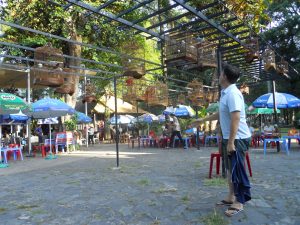
Hanging a bird
It was our luck to sit beside a Vietnamese-American man from California who took great pleasure in explaining the culture of this place and pointing out the different species of birds as their owners began arriving with them in ever increasing numbers. He comes to Saigon every few years to visit his remaining family here. They were the ones who remained behind in the late 1970s so he, at age 15, and his young cousins, could escape. He always stays at the same hotel, a couple of blocks from the bird café. Within days of arriving he goes to the market and buys a songbird, this time it was a red-whiskered bulbul. They don’t dance like some of the others nor do they have the most beautiful songs, but for him the Asian variety of red-whiskered bulbuls have a song that is evocative of this bird café. I suspect the sound of a mass of songbirds in full voice might evoke memories of Tao Dan park for us as well. Here’s a minute or so of what we heard.
Sunday, 4 Nov. 2018: What’s it like to feed crocodiles from a boat? Frightening, even from behind a protective rail! The picture shows a little fishing line from which dangled a morsel of cut-up eel. Obviously, there was no hook – you don’t want to actually catch one of these 2-3 meter monsters. The ferocity and suddenness of their movements stay with you long after the moment.

Feeding crocodiles
We were at the Mangrove Forests outside Ho Chi Minh City, an area ravaged by agent orange during the war but now recovered enough for tour groups like ours. The jungle was intense and eerie.

Swamp Roots
It was a relief to climb a watch tower and look for miles above the canopy. Not the right season for birding, but still plenty of egrets, cormorants and others to catch the eye.
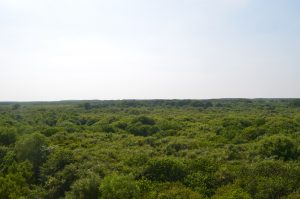
Recovered Mangrove Forests, Vietnam
Finally, a view of the entrance to the famous Saigon bar Apocalypse Now on Halloween. Not many locals have heard of or seen the movie. Mostly it’s for foreigners!
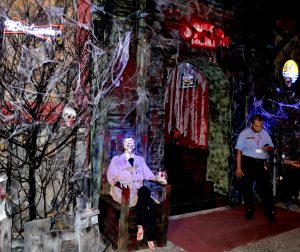
Halloween, Apocalypse Now bar, Ho Chi Minh City
Saturday, 20 Oct. 2018: “In the ‘Doi Moi (Reform)’ period, Vietnamese women have continued to be a major labour force, increasingly showing the ability to contribute a significant part to the cause of national renovation and integration into the global economy. Ao dai and Vietnamese women have been present in all professions and women have confidently played the same roles as men in every field which contributes to the society. Therefore, in external affairs and promotion of Vietnamese culture, Vietnamese women are charming in Ao dai.” – from a display in the Women’s Museum, Ho Chi Minh City
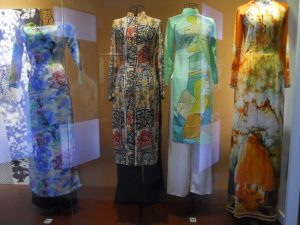
Today is Women’s Day in Vietnam, which has been described to us as a sort of second Valentine’s Day in which Vietnamese men scramble to buy flowers and gifts for all the women in their lives. Nobody disputes that Vietnamese women look terrific in the traditional Ao dai. Above are a few amazing examples of the dress from the Women’s Museum here in Ho Chi Minh City.
But the museum also makes clear that women played a formidable role throughout the bitter years of warfare. This statue is called “Mother Gunner.”
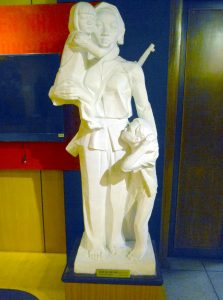
Here Suzanne is negotiating for lilies at a market down the street from where we are now living. After a month or so of mostly travels, we are spending the bulk of the rest of our time here living in a fine apartment on quiet Phung Khac Khoan St., home of several consulates, but within convenient walking distance to good shopping and many of the sites of downtown. We’re trying to write in the mornings and explore in the afternoons. No shortage of things to see and ponder!
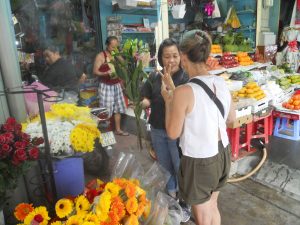
Happy Women’s Day!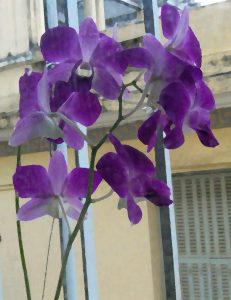
Wednesday, 26 Sept. 2018: The Museum of Fine Arts in Hanoi is a real eye-opener. They have one of the best collections of war art I’ve ever seen; the few photos I have here (photos are encouraged at the museum) give only a glimpse of the range, depth and sophistication of depictions of ordinary life, as well as battles and other military operations, during Vietnam’s many years of war. Here are a few examples, though:

Commemoration by Nguyen Phu Cuong 1990
This haunting bronze statue captures the sense of the lurking death that affected every family in this country during the long fighting.
I also was struck by They Conducted a New A-Bomb Test Again. It was done in 1958 by Nguyen Duc Nung. I found myself wondering how the American public, back in the mid-1960s, might have reacted if they knew that the objects of bombing campaigns larger than during World War II could produce such striking art?

They Conducted a New A-Bomb Test Again by Nguen Duc Nung 1958
This is Fighting against Drought by Phung Van Pham in 1990, depicting a society that has been fighting for life, liberty and livelihood for millennia.

Fighting Against Drought by Phung Van Pham 1990
It’s not all struggle, though. Here is Happiness (1939) by Pham Gia Giang.

Our travels continue to be wondrous, although I am suffering from a bit of a stomach thing at the moment. We have headed to Laos for a few days to poke around here, and to get a longer term Vietnam visa for when we return in a few days and try to figure out where we want to spend our time in the next few months.

Alan, Suzanne, Helena and guide Ha at the water station in My Chau
Wednesday, 19 Sept. 2018: Lots to think about in the last few days as we moved north across the DMZ — the old border between South and North Vietnam — and spent a bit of time underground. The tunnels at Vinh Moc village were featured in a Parts Unknown episode when Anthony Bourdain visited Hue and took a side trip to Vinh Moc. This mural in the information centre says it all — the village did what it needed to do to survive severe bombardment during the war. 
They dug over two kilometers of trenches deep enough to not be bothered by special bombs that drilled into the soil, and their compound included a maternity ward, bedrooms and storerooms. At its peak, the tunnels sheltered up to 600 people. Walking through them, I had to bend double in places — they have been kept in their original condition, a stunning symbol of (it seems to me) the futility of trying to use brute force to change the will of others.
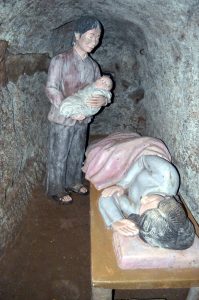 Later, we boated to the famous caves at Phong Nha, and were treated to eerily beautiful views of limestone caverns that have been blowing the minds of tourists for generations. It’s breathtaking to slip under the lip of that cave and watch wondrous sights appear. This too, according to our guide, served as shelter for North Vietnamese troops during the war, and was the target of American bombardment.
Later, we boated to the famous caves at Phong Nha, and were treated to eerily beautiful views of limestone caverns that have been blowing the minds of tourists for generations. It’s breathtaking to slip under the lip of that cave and watch wondrous sights appear. This too, according to our guide, served as shelter for North Vietnamese troops during the war, and was the target of American bombardment.


Friday, 14 Sept. 2018: What to say about the My Son temples?
They were built by the mysterious Cham peoples over a period of centuries, and abandoned about 600 years ago or so as the Viet people were coming in from the north. They lie in a valley between mountains and are difficult to get to. According to our guide, they would’ve been used by emperors and the religious class as a means of communion with the gods. They are Hindu in origin with Cham flavouring.
They are also in ruins and yet intensely beautiful, surrounded by those mountains and by lush, lush jungle. We visited them on a hot day, but then again, every day is hot here – we seem to be sweating through our clothes constantly. The other interesting thing is that, as Suzanne noted to me, the locals forgot about the importance of the temples, though raided the site for bricks when needed. Like many other ancient ruins, they were rediscovered, completely overgrown, by Europeans and rehabilitated with an international effort. My Son is now a UNESCO site, and it provides for significant employment in the region as tourists flock. Oh yes, it was also the scene of some intense fighting during the Vietnam war (known as the American war here). North Vietnamese fighters sought shelter in the temples; the Americans bombed and destroyed a number of the temples; what’s still apparent is the bomb craters and the bullet holes in the brickworks. (Yes, those are gold fish in the bomb crater.)
We heard about an American tourist who got lost in the surrounding jungle not too long ago and was only found after an intensive search involving soldiers. I tried to imagine what it would be like for a young American soldier, or Vietnamese for that matter, to struggle through that jungle when all hell was breaking loose.
On a related matter, I just got news that my friend and former colleague at VCFA, Elizabeth Partridge, has been shortlisted for the National Book Award in the United States for her book on the Vietnam War Boots on the Ground. Congratulations Betsy – sounds like a great read!
Monday, 10 Sept. 2018: We have been on the road for a week now, although “on the road” is a bit misleading – a fair amount of that time has been in the air, flying halfway around the world. The first several days were spent in Hong Kong, and now we are in Ho Chi Minh City, Vietnam. There’s way too much to mention, but a few highlights:
— sitting on the E23 bus from the airport to Kowloon, after 15 hours in the air, and through our exhaustion, watching a man writing characters by hand on his phone — a lovely bit of functional art on a hot and sweaty night;
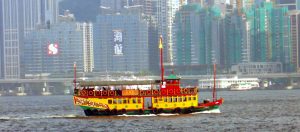
— walking along the Hung Hom Promenade in Kowloon, checking out the harbour traffic, looking at the skyscrapers of Hong Kong across the water, sweating, sweating in the heat, carrying umbrellas to ward off the sun, watching the runners, so many of them shirtless men, sweating, sweating sweating;
— searching fruitlessly for a Hong Kong city map, and then stumbling upon the miraculous “central mid-level escalator” in Hong Kong, an innovative bit of public transport engineering, a pragmatic High Line that allows for mass walking without the pain of dealing with traffic or having to climb steep slopes without aid;
— wandering into a tai chi park in Kowloon in the early morning and doing a quiet set surrounded by dozens of groups of mostly seniors doing a dizzying variety of physical exercises in the shade of tropical trees before the merciless sun rose too high;
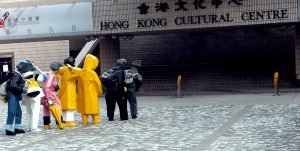
— flying to Ho Chi Minh City (Saigon) and being greeted by our dear dear friend Helena whom we have known since our China teaching days over 30 years ago; –riding into the city in a taxi and being gobsmacked by the motorbike traffic, in particular the way it moves like schools of fish, and how our taxi driver, never signalling, never stopping, moved elegantly through and around and among the bikes;
–riding into the city in a taxi and being gobsmacked by the motorbike traffic, in particular the way it moves like schools of fish, and how our taxi driver, never signalling, never stopping, moved elegantly through and around and among the bikes;

–in particular, watching a young woman sitting on the back of a motorbike, her legs crossed, nonchalantly reading her phone while the young man driving the bike steered through the swarms of traffic;
–experiencing a foot massage, which actually engaged the entire body, and lasted an hour, and would be practically a novel in itself to describe, especially the finale when the tiny masseur had both my arms stretched behind me and was manipulating my back muscles with his feet, and urging me to keep hold of his wrists while I wondered which part of my spine was going to go ka-boing;
— loving being here, every moment of it, especially the food which I will have to take another post to describe.
*********
Sunday, 2 Sep. 2018: Thirty-two years ago, when Suzanne and I had been married for less than two months, we took off for a year of English teaching in China. That year is very much on our minds today as we prepare to fly to Vietnam for four months of travel, and everything that goes with it. Here’s an excerpt from a letter I wrote to my parents about that long flight, in August 1986, to Hong Kong. Tomorrow, when we start our journey, we will be heading to Hong Kong again for a few days and will stay in the same guesthouse that we stayed in so long ago (the Holy Carpenter Guest House in Kowloon. Despite my dismissive note below, it gets great ratings these days on Tripadvisor, and we’re really looking forward to seeking our rest there again in a couple of days):
We were about 16 hours in the air from New York to Seoul.… The time went fairly quickly, although it became difficult to sleep when the air conditioning went on the blitz [I think I must’ve meant fritz?] and we got hot air blasted at us. The 747 is a huge plane, as you know, and there was an entire back section of dedicated smokers who managed to pollute much of the air for all of us.… I got along all right but Suzie was quite woozy for the last few hours. The sun didn’t go down all the way around the planet, and we didn’t actually need to change our watches, since Chinese time is exactly 12 hours different from Toronto time… [The plane landed in Seoul and] after a couple of hours’ wait we flew to Hong Kong, which is quite the place – arrived at night during a typhoon and had quite a swooping descent. We were trying to fill out our immigration cards while the plane dipped and bucked in the wind. Managed to get through customs all right and left the bulk of our luggage at the Left Luggage counter in the airport, then caught a cab ($100 Hong Kong) to the Christian hostel in the grubby side of town where we’d been booked in. So after a day and a half of plane travel we finally hit solid ground. I slept like a log and Suzie was wide awake most of the night…”
There’s often plenty to complain about air travel these days, but that flight 32 years ago was formidable! We’re hoping for a smoother ride this time…
Here we are a few days later, in Nanjing, set to start our new lives together.

